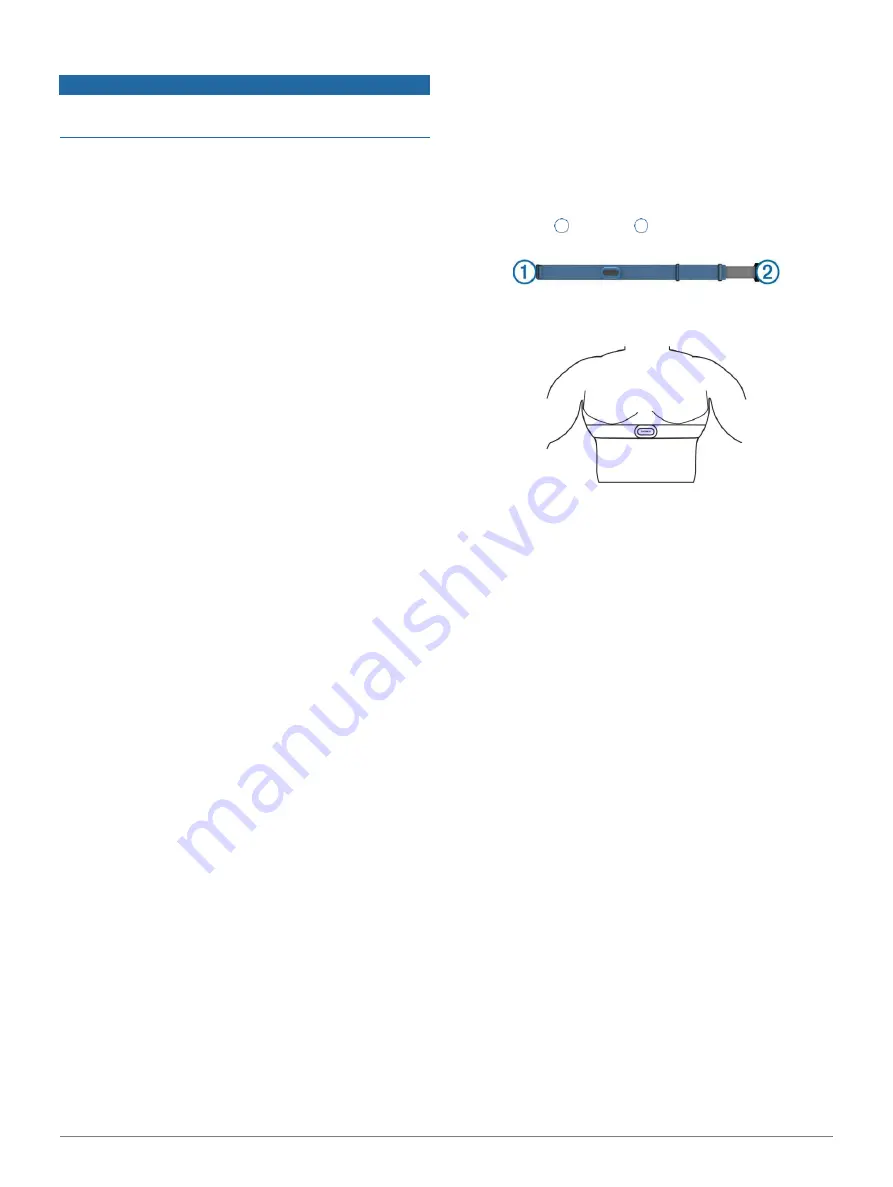
Heart Rate Features
17
1
2
Caring for the Heart Rate Monitor
NOTICE
A buildup of sweat and salt on the strap can decrease the
ability of the heart rate monitor to report accurate data.
Rinse the heart rate monitor after every use.
Hand wash the heart rate monitor after every seven
uses or one pool swim, using a tiny amount of mild
detergent, such as dishwashing liquid.
NOTE:
Using too much detergent may damage the
heart rate monitor.
Do not put the heart rate monitor in a washing
machine or dryer.
When drying the heart rate monitor, hang it up or lay it
flat.
Tips for Erratic Heart Rate Data
If the heart rate data is erratic or does not appear, you can try
these tips.
Reapply water to the electrodes and contact
patches (if applicable).
Tighten the strap on your chest.
Warm up for 5 to 10 minutes.
Follow the care instructions (
Wear a cotton shirt or thoroughly wet both sides of the
strap.
Synthetic fabrics that rub or flap against the heart rate
monitor can create static electricity that interferes with
heart rate signals.
Move away from sources that can interfere with your
heart rate monitor.
Sources of interference may include strong
electromagnetic fields, some 2.4 GHz wireless sensors,
high-voltage power lines, electric motors, ovens,
microwave ovens, 2.4 GHz cordless phones, and wireless
LAN access points.
HRM-Swim Accessory
The device can record heart rate during your swim
(
Chest Heart Rate While Swimming, page 16
Sizing the Heart Rate Monitor
Before your first swim, take some time sizing the heart rate
monitor. It should be tight enough to stay in place when
pushing off the pool wall.
Select a strap extender, and attach it to the elastic end of
the heart rate monitor.
The heart rate monitor comes with three extender straps
to fit different chest sizes.
TIP:
The medium strap extender works for most shirt
sizes (from medium to extra-large).
Put on the heart rate monitor backward to easily adjust
the slider on the strap extender.
Put on the heart rate monitor forward to easily
adjust the slider on the heart rate monitor.
Putting On the Heart Rate Monitor
You should wear the heart rate monitor directly on your skin,
just below your sternum.
1
Select a strap extender for the best fit.
2
Wear the heart rate monitor with the Garmin logo
facing right- side up.
The hook
and loop
connection should be on
your right side.
3
Wrap the heart rate monitor around your chest, and
connect the strap hook to the loop.
NOTE:
Make sure the care tag does not fold over.
4
Tighten the heart rate monitor so it is snug around your
chest, but not restrictive.
After you put on the heart rate monitor, it is active,
storing, and sending data.
Tips for Using the HRM-Swim Accessory
Adjust the tightness of the heart rate monitor
and strap extender if the heart rate monitor slides down
your chest when pushing off the pool wall.
Stand up between intervals so that the heart rate
monitor is out of the water to see your heart rate data.
Running Dynamics
You can use your compatible Forerunner device paired
with the HRM-Pro accessory or other running dynamics
accessory to provide real-time feedback about your
running form.
The running dynamics accessory has an accelerometer that
measures torso movement in order to calculate six running
metrics.
Cadence:
Cadence is the number of steps per minute. It
displays the total steps (right and left combined).
Vertical oscillation:
Vertical oscillation is your bounce
while running. It displays the vertical motion of your
torso, measured in centimeters.
Ground contact time:
Ground contact time is the
amount of time in each step that you spend on the
ground while running. It is measured in
milliseconds.
















































